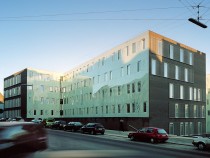
© Ivar Mjell
The annex provides an additional floor area of 14,000 m2 for the civic administration. To integrate its large volume into the urban fabric, the building was articulated on all sides with deep indentations. The printed glass faces to these recesses were designed by the artist Finn Skødt and form a bold contrast to the reddish-brown brickwork of the main facade areas. In each wing of the building, the offices are oriented to the outside and are laid out around waiting areas and communication zones. The large, glass-covered atrium at the centre was inspired by that in the main town hall, dating from 1942, by Arne Jacobsen and?Erik Møller. The new vestibule provides access to the upper floors via three glazed lifts?and a slender main staircase. The stairs span between thin, bridge-like walkways that extend across the hall on every floor. Both the?stair flights and the walkways were executed in fibre-reinforced concrete. This composite material contains densely laid ribbed-steel reinforcement and a high proportion (up to 6 per cent) of reinforcing fibres. The slender form of construction, consisting of a central supporting beam with cantilevered treads or slabs finished with ash parquet flooring, heightens the overall sense of space.




